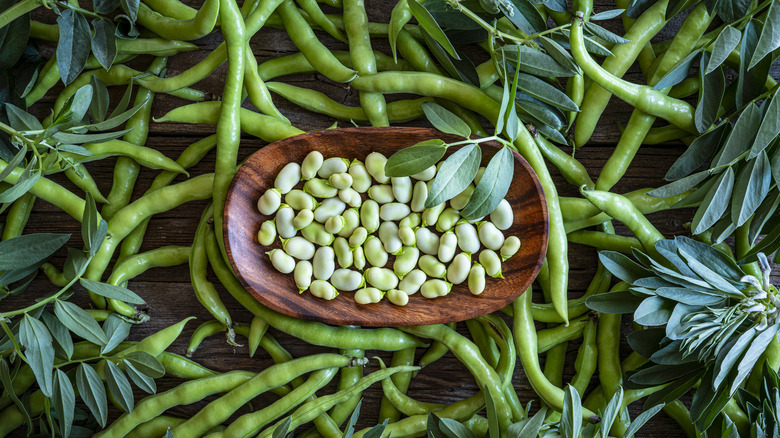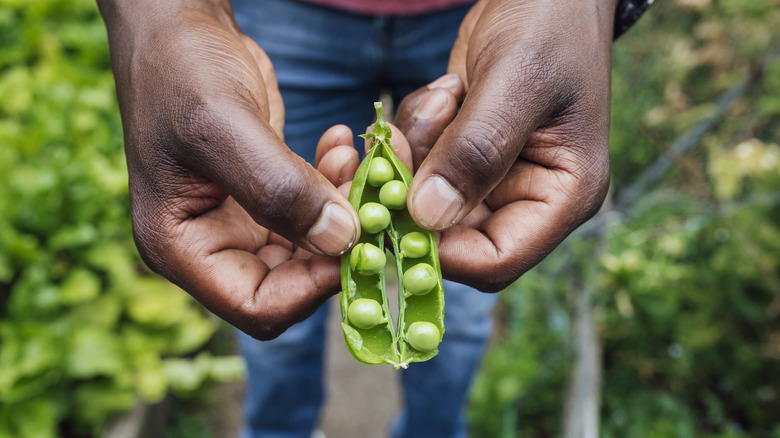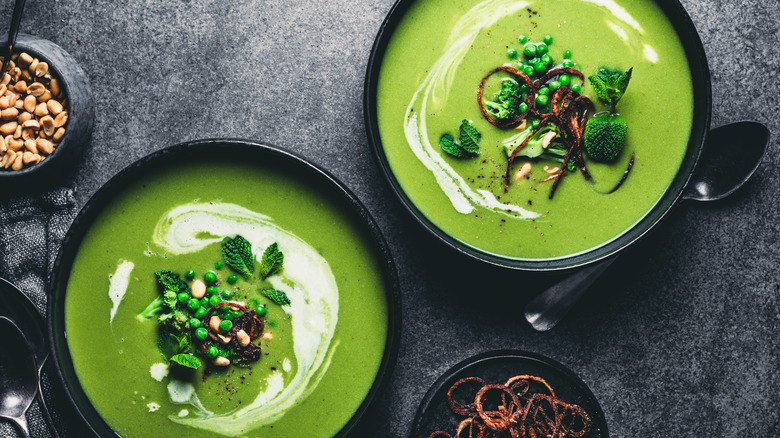The Main Differences Between Fava Beans And Peas
Grown in fuzzy little pods, vibrant green in color, and effortlessly easy to incorporate into a slew of recipes — we're talking about peas. Or wait, are they fava beans? While most Americans are familiar with peas, fava beans are not as commonly used in the States. This equally versatile bean may seem like a close cousin to peas at first glance, but they're far from the same. Both of these legumes are good for the body, grown inside pods, green in color, and spherical in shape, but the main differences between fava beans and peas lie in their taste and texture.
While fava beans lend a naturally buttery and earthy flavor, peas tend to have a deep, sweet flavor, depending on the variety. As chef Ronna Welsh shared with Martha Stewart, these differences may seem subtle, but they are far from it. "Cooked fresh peas taste vegetal — almost leafy ... Favas, however, are grassy, yet creamy," she said. Flavors aside, fava beans are also larger and flatter than peas, which are typically small and round. Still, these aren't the only qualities that set the beans apart.
More differences between these bright legumes
While you can consume most of the many different varieties of peas along with their pods, you can only eat fava bean pods when the plant is very young, as the shell becomes extra fibrous and tough over time. This usually makes fava beans much more expensive than peas, too, as their tough shells and skins create a much more labor-intensive harvesting process.
Finally, another big difference between peas and fava beans is how different the preparation process is between the legumes. When it comes to peas, the process is as easy as shelling them from the pod and heating them with your cooking appliance of choice. If you prefer to use the pod, the process is even easier, as you can simply wash and throw them in your dish whole.
With fava beans, however, the process is a little more involved. First, you must extract the beans from the pod, which is easier said than done, considering the tough casings. Next, you blanch them to release their hidden flavors. Then, either peel the skins off or leave them on for some added flavor. To peel or not to peel is a hotly debated topic, as some parts of the bean's skins are bitter, while others are more flavorful. At the end of the day, it's your kitchen, so the choice is entirely yours.
How to incorporate these beans into a recipe
Aside from the similar look of these beans, peas and fava beans also share the trait of versatility. Both of these legumes can be eaten raw or cooked, and can also be dried for later use, and there are a lot of meals they'd do well in. Peas, for example, can serve as a base for a pesto thanks to their mild flavor, or thrown into a simmering pot of risotto to round out the dish with earthy flavors and vibrant green hues. Dried split peas can be used in wholesome dishes like split pea soup, and will further release their distinctive flavors once they've been rehydrated and blended for this hearty dish.
Alternatively, there are many great ways to enjoy fava beans, too, and because of the similarities between these legumes, many of the recipes you can use them in are the same. For example, earthy fava beans can also serve as a base for spreads and sauces or incorporated into a ravioli filling with ricotta and enlivening herbs and spices. Since dried fava beans impart a similar flavor to chickpeas, they can also be used to make a creamy fava bean hummus.
Both of these versatile legumes are great staple vegetables to keep on hand, thanks to their adaptability. Still, depending on what flavor and texture you want in your dish, keep their differences in mind, too, before making a choice.


